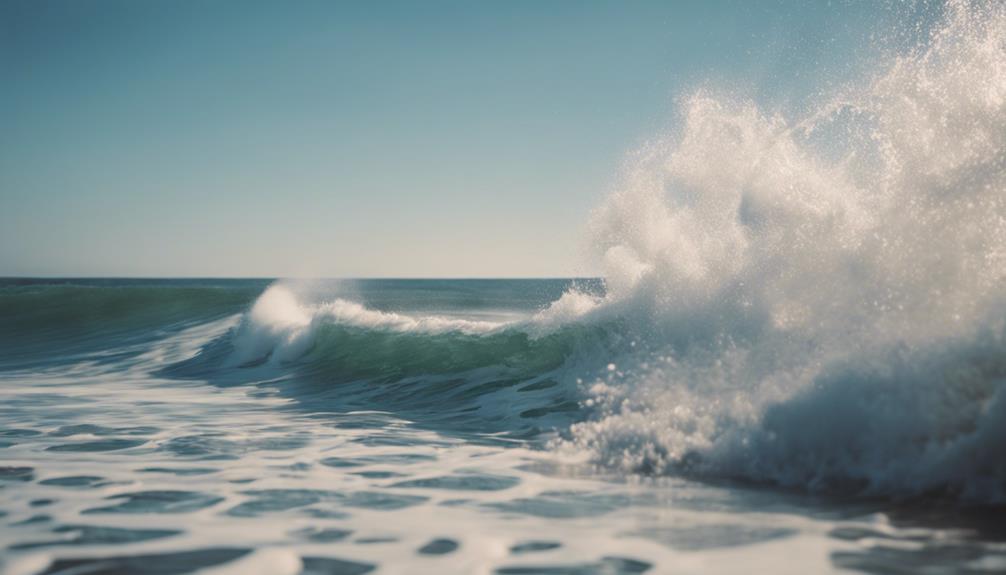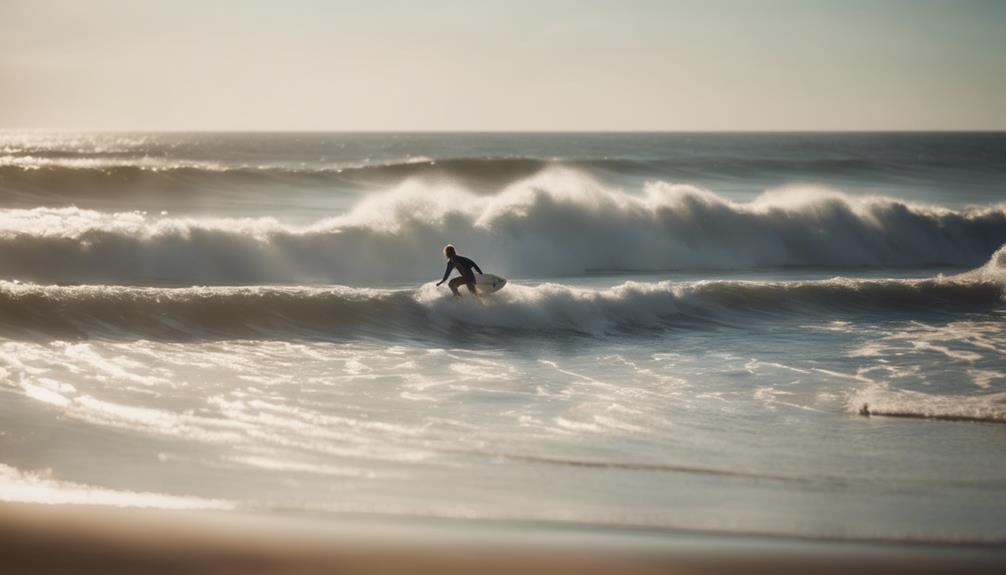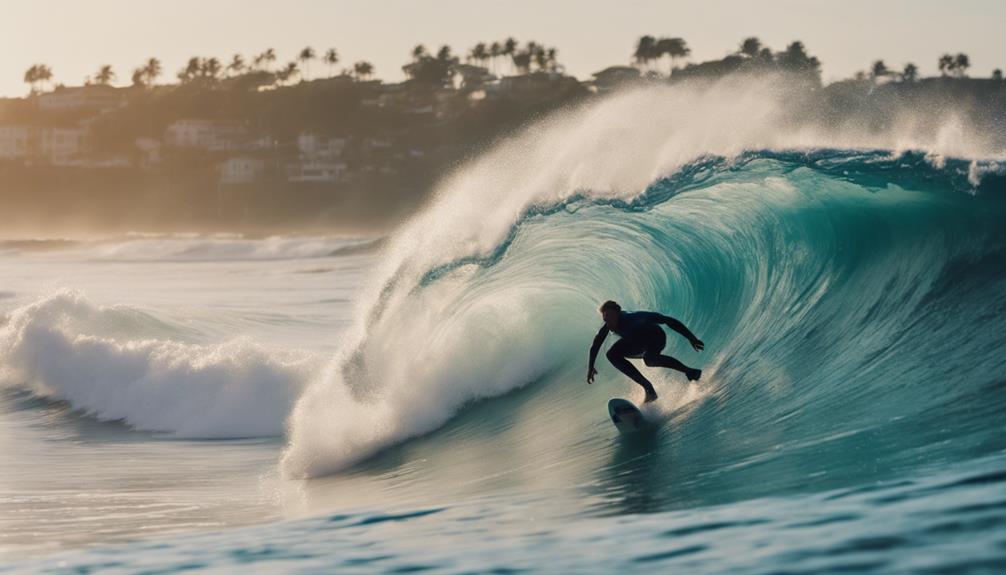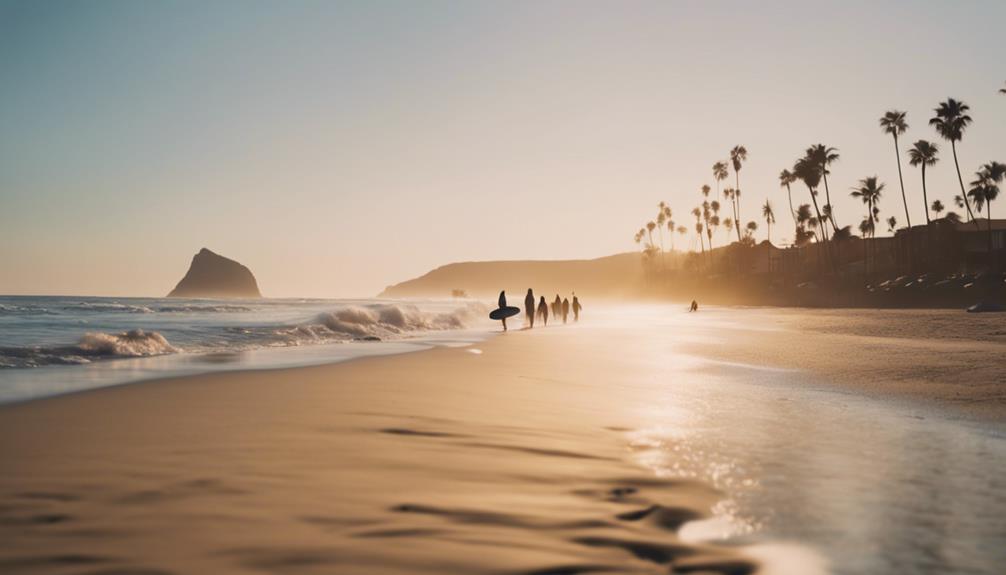Surfing waves come with specific names that help you understand their behavior and what to expect. You've got beach breaks, which are great for beginners, and point breaks, offering long, rideable waves. Experienced surfers often tackle reef breaks for their powerful waves. There's the exciting barrel wave, perfect for tube rides, and choppy waves, which can be a bumpy ride. Each type affects your surfing experience differently, from wave power to how you navigate them. Discovering more about these wave types will enhance your surfing journey and improve your skills on the water.
Key Takeaways
- Surfing waves are categorized into types like beach breaks, point breaks, and reef breaks, each offering different experiences for surfers.
- Barrel waves provide a tube riding experience, considered one of the most thrilling types of surf.
- Choppy waves are unpredictable and less desirable due to rough conditions caused by onshore winds.
- Key wave anatomy includes the crest, trough, pocket, and spindrift, each contributing to the wave's characteristics.
Understanding Wave Anatomy
To truly appreciate surfing, you need to understand the anatomy of a wave, including its crest, trough, and the essential areas like the pocket where you can catch the best rides. The crest is the highest point of the wave, while the trough is the lowest, defining the wave height and shape. When you ride the face of the wave, you're engaging with its front surface, which provides the energy necessary for your maneuvers.
As you observe a wave, notice the spindrift, the spray that forms when wind blows over the crest, adding a visual thrill to the experience. While the backside of the wave faces away from the shore and isn't typically used for surfing, it plays a significant role in understanding wave dynamics. The pocket, located near the curl, is the prime spot for generating speed and performing tricks, making it essential for any surfer.
Understanding these elements of wave anatomy helps you better connect with the ocean. By recognizing the dynamics of the crest, trough, and pocket, you can enhance your surfing experience and improve your skills on the water.
Different Types of Surfing Waves

Surfing offers a diverse array of wave types, each with its own unique characteristics and challenges that cater to different skill levels and preferences.
Whether you're a novice or an experienced surfer, understanding these wave types can enhance your experience in the water.
- Feel the rush of riding powerful waves.
- Experience the thrill of tube riding in barrel waves.
Beach breaks are perfect for beginners, as they offer breaking waves over sandy bottoms.
In contrast, point breaks provide long, rideable waves that can lead to consistent surf conditions, making them a favorite among many surfers.
For those seeking a challenge, reef breaks deliver well-formed, powerful waves that can test your skills and push you to improve.
However, you might encounter choppy waves, which are less desirable due to their unpredictable and rough nature.
Each type of wave contributes to the rich tapestry of surf culture, showcasing the beauty and diversity of the ocean.
As you explore these different wave types, you'll discover what resonates with you, making your surfing journey even more rewarding.
Wave Behavior and Characteristics

Understanding different types of surfing waves sets the stage for exploring how they behave and their unique characteristics as they approach the shore. Wave behavior varies considerably, impacting surf conditions. For instance, as waves travel towards the coastline, they undergo refraction, bending due to changes in depth, which can alter the wave characteristics at different points.
When waves start jacking up, their height increases dramatically just before breaking, creating powerful surf conditions. Diffraction occurs when waves meet obstacles, spreading their energy and changing the wave shape. After a wave breaks, the backwash, or the water that flows back to the ocean, plays a role in how quickly you can catch the next wave.
Here's a quick look at some key wave characteristics:
| Wave Characteristic | Description |
|---|---|
| Wave Period | Time between consecutive waves |
| Wave Power | Energy within a wave |
| Wave Breaks | Points where waves collapse |
| Backwash | Water retreating after breaking |
| Refraction | Bending of waves near shore |
Surf Conditions and Influences

Often, the quality of your surf session hinges on various conditions that can dramatically influence wave performance and shape. Understanding these factors can make the difference between an exhilarating ride and a frustrating day on the water.
Feeling the thrill of riding perfectly shaped waves, the joy of catching the perfect swell, and the disappointment of choppy, unrideable surf are all part of the surfing experience.
Offshore winds create cleaner waves with well-defined shapes, enhancing your surfing experience. In contrast, onshore winds lead to choppy surf conditions that can ruin even the best swell.
The swell period is essential; longer periods generally mean more powerful and organized waves. Fetch also plays an important role—greater fetch tends to produce larger, more powerful waves.
Tide effects are critical, too. High tide can amplify wave height and energy, while low tide may expose the ocean floor, altering wave shape and breaking patterns.
Essential Surfing Techniques and Safety

Mastering essential techniques and safety practices is essential for any surfer looking to enjoy their time in the water while minimizing risks. Knowing how to perform a duck dive allows you to paddle out effectively, slipping beneath breaking waves with ease. When you catch a wave, executing a smooth pop-up is important for getting to your feet quickly. As you ride, don't forget to use a cutback to maintain control and speed as you maneuver back towards the breaking section.
Being aware of rip currents is fundamental. If you encounter one, swim parallel to the shore to escape its grip. Practicing surfing etiquette is also key; understanding right of way can help prevent collisions and create a respectful surf session for everyone.
Here's a quick reference table for these techniques:
| Technique | Purpose | Safety Tip |
|---|---|---|
| Duck Dive | Paddle beneath waves | Keep your board low to minimize drag |
| Pop-Up | Change to standing | Use a fluid motion for balance |
| Cutback | Change direction on the wave | Stay low for better control |
With these skills, you'll be better equipped to handle various surf spots and conditions.
Frequently Asked Questions
What Do Surfers Call Waves?
Surfers call waves by various names, like 'A-frames' for symmetrical breaks, 'barrels' for hollow tubes, and 'beach breaks' for sandbar conditions. You'll also hear terms like 'rogue waves' and 'swell' for energy-driven waves.
What Are the 7 Types of Ocean Waves?
When you gaze at the ocean's dance, you'll discover seven types of waves: wind, swell, tsunami, capillary, seiche, and more. Each one carries its unique story, inviting you to explore their enchanting rhythms.
What Are Sets of Waves Called?
Sets of waves are often referred to simply as "sets." When you're out surfing, you'll notice these groups arrive together, providing you with prime opportunities to catch the best waves for your ride.
What Are the Different Wave Terms?
You might think all waves are just water, but terms like A-frame, barrel, and closeout reveal a world of nuance. Understanding these terms helps you navigate the surf, making every ride a thrilling adventure.
What are the different wave names and types that surfers should be aware of?
Surfers should be familiar with different types of surfing waves to maximize their experience. Some popular wave names and types include point break waves, reef break waves, beach break waves, and river wave. Each type offers unique challenges and opportunities for skilled surfers to navigate and enjoy.
Conclusion
In summary, understanding the anatomy and types of surfing waves is vital for enhancing your skills and safety on the water.
Did you know that about 80% of surfers encounter waves that are classified as 'beach breaks,' which are often more unpredictable than reef breaks?
By grasping wave behavior and conditions, you can better navigate the surf, making your experience both thrilling and safe.
So, gear up, stay informed, and enjoy riding those waves!










